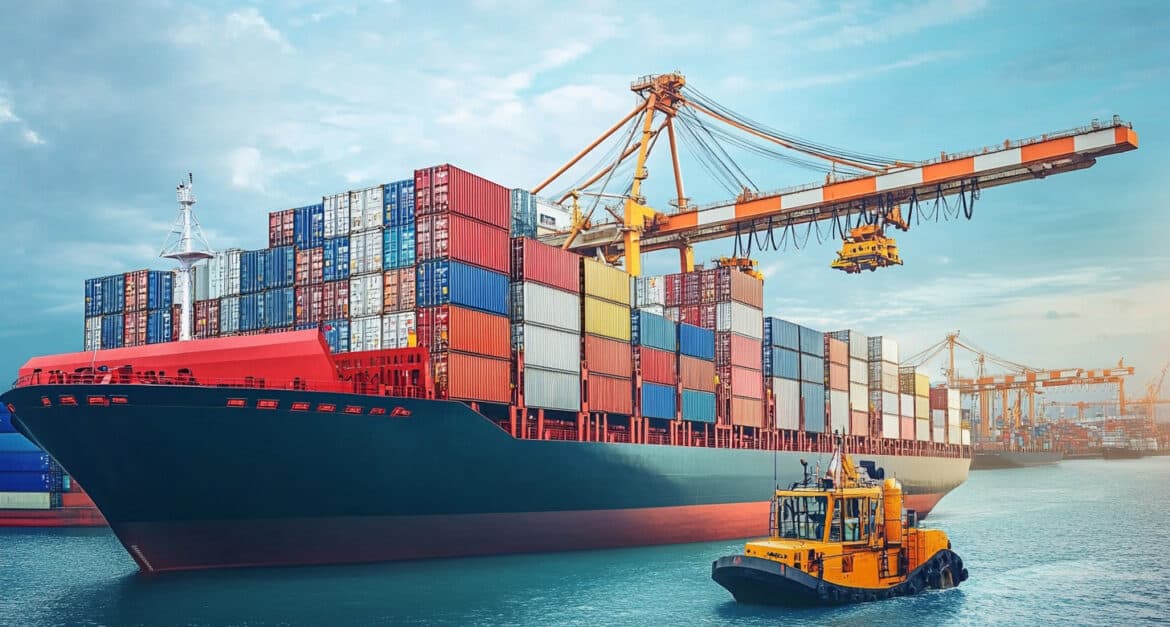

Dealing with supply chain disruptions is a big headache for many businesses. One key fact: these disruptions can really shake up the global economy. This article will show ways to manage these disruptions, making your business stronger.
Keep reading to learn how to stay resilient.
Key Takeaways
- Supply chain disruptions, such as natural disasters and pandemics, impact global economies by affecting production and delivery times. Companies will adopt near-shoring in 2024 to build more resilient supply chains.
- Key strategies for managing these disruptions include diversifying suppliers, strengthening communication with partners, and utilizing technology for real-time tracking. This approach enhances businesses’ agility and ability to adapt quickly.
- Case studies like the Covid-19 pandemic and the Suez Canal obstruction illustrate the significant effects of unexpected events on global supply networks. Firms that invest in flexibility, technological advancements, and supplier relationship management can better navigate future challenges.
- Building a future-proof supply chain requires focusing on sustainability, adopting digital engineering and manufacturing processes, and implementing artificial intelligence (AI) for improved decision-making capabilities.
- Resilient supply chains are crucial for national security and economic stability. They rely on strong planning, effective risk management strategies, and continuous improvement efforts to withstand disruptions.
What is Supply Chain Disruption and Why It Matters
Supply chain disruption occurs when a significant event interrupts the flow of goods and services. These disruptions can lead to severe impacts on businesses and the global economy, affecting everything from production schedules to customer satisfaction.
Definition of supply chain disruption
Supply chain disruption refers to interruptions that affect the flow of goods and services. These disruptions can arise from various factors like natural disasters, pandemics, or economic shifts.
In today’s global economy, businesses face complex challenges in supply chain management. A single unexpected issue with one supplier can significantly impact the entire supply chain.
In 2024, companies are expected to adopt near-shoring strategies to build more resilient supply chains. Diversifying suppliers and strengthening communication channels will enhance agility and risk mitigation while navigating these disruptions.
Understanding this definition sets the stage for exploring its broader implications and strategies for managing such challenges effectively.
Impact on global economy
Supply chain disruptions significantly impact the global economy. Businesses face challenges from natural disasters, pandemics, and economic shifts. These issues can disrupt production and delivery timelines.
An unexpected disruption in one area affects the entire supply chain. In 2024, companies will adopt near-shoring strategies to enhance resilience. They aim to secure stable access to products and services.
Resilient supply chains play a vital role in national security as well. Diversifying suppliers helps mitigate risks of global disruptions. Technology enables real-time tracking for better management of supply chain interruptions.
Strengthening communication fosters collaboration with partners and suppliers, which is essential for effective crisis management. Agility in processes allows businesses to adapt quickly and minimize disruption impacts.
Reasons for supply chain disruption (natural disasters, supplier issues, demand volatility, etc.)
Natural disasters often lead to supply chain disruptions. Floods, earthquakes, and hurricanes can damage infrastructure or halt production. Supplier issues also cause significant delays.
A company’s reliance on a single supplier makes it vulnerable to problems like bankruptcy or labor strikes.
Demand volatility creates challenges as well. Unexpected spikes in demand can deplete inventory quickly. Companies must then scramble to meet consumer needs while managing limited supplies.
In today’s global economy, diversifying suppliers and partners helps minimize the impact of these disruptions. Embracing technology for real-time tracking allows businesses to respond swiftly and maintain resilience in their supply chains.
Strategies for Managing Supply Chain Disruptions
Companies need to adopt a resilient supply chain approach. They can manage risks and challenges by utilizing technology and data effectively.
Resilient supply chain approach
A resilient supply chain approach focuses on preparation and adaptability. Businesses face many supply chain challenges today, making resilience critical. Companies must prepare for disruptions from natural disasters, pandemics, or economic shifts.
By diversifying suppliers and partners, they can better manage risks. Embracing technology offers real-time tracking to respond effectively to disruptions.
Creating strong relationships with partners enhances communication and collaboration. Transparency is vital for minimizing the impact of disruptions. Agile processes allow businesses to adapt quickly and mitigate issues in their supply chains.
For national security, resilient supply chains ensure secure acquisition of products and services as companies plan for future demands in 2024 and beyond.
Managing risks and challenges
Businesses face many risks and challenges in managing supply chains. Disruptions can arise from natural disasters, supplier issues, or economic shifts. Companies often deal with traditional supply chains that can turn vulnerable quickly.
An unexpected problem in one area can significantly impact the entire chain. Diversifying suppliers and partners builds resilience in navigating supply chain disruptions. This strategy helps companies adapt to changes more effectively.
Embracing technology plays a key role in managing these risks. Real-time tracking enables businesses to respond swiftly to any disruption within their systems. Strong communication and collaboration with suppliers enhance overall transparency throughout the supply chain process.
Agility becomes crucial as firms implement flexible processes to tackle various challenges head-on. Staying prepared equips businesses better for potential future events and improves logistics operations significantly.
Utilizing technology and data
Technology and data play crucial roles in tackling supply chain disruptions. Companies can utilize real-time tracking systems for better visibility. This allows them to manage and respond swiftly to any issues that arise.
Adopting these technologies helps businesses minimize the impact of disruptions on their operations.
Strong communication channels enhance collaboration among partners. Effective use of data improves demand forecasting, which leads to better inventory management. Companies that embrace technology strengthen their resilience strategies against future disruptions, ensuring they remain agile in an unpredictable environment.
Key Elements of a Resilient Supply Chain
A resilient supply chain requires effective planning and strong logistics management to adapt quickly to changes. Companies must manage procurement wisely and build solid relationships with suppliers.
These elements create a system that can withstand disruptions. Explore these key factors further to understand how they enhance resilience.
Supply chain planning
Supply chain planning plays a vital role in building resilience. Businesses must anticipate disruptions, such as natural disasters or pandemics. Effective planning includes identifying key suppliers and diversifying them to minimize impact during crises.
In 2024, companies are set to adopt near-shoring strategies to enhance supply chain strength further.
Real-time tracking technology improves supply chain management. It allows businesses to respond quickly to challenges. Strengthening communication with partners helps sustain operations during disruptions.
With agile processes in place, organizations can adapt swiftly and maintain efficiency even when faced with unexpected events.
Logistics and transportation management
Logistics and transportation management play a crucial role in building strong supply chains. Businesses must ensure that goods move efficiently from suppliers to customers. Improving these processes helps companies minimize the impact of disruptions.
In today’s global economy, firms face challenges like natural disasters and pandemics that can interrupt their operations.
Real-time tracking technology allows businesses to manage their logistics better. This innovation enhances transparency in communication with partners. By employing agile strategies, companies adapt quickly to changes in demand or other unexpected events.
Diversifying suppliers strengthens resilience against disruptions, ensuring continuous product flow despite obstacles on the path ahead.
Procurement and supplier management
Effective procurement and supplier management play crucial roles in building resilient supply chains. Companies must diversify their suppliers and partners to minimize the impact of disruptions.
In 2024, many businesses will adopt near-shoring strategies to enhance supply chain security. Strong relationships with suppliers lead to better collaboration during crises. Utilizing technology for real-time tracking helps firms respond quickly when issues arise.
Agility in supply chain processes enables companies to adapt easily to challenges. Transparent communication keeps everyone informed and engaged, minimizing confusion during disruptions.
Implementing risk management strategies ensures that businesses can navigate uncertainties effectively. Continuous improvement strengthens overall performance and prepares organizations for future disruptions in the supply chain landscape.
Case Studies: Real-Life Examples of Supply Chain Disruptions
Case studies showcase real-life examples of supply chain disruptions. They highlight the effects of events like the China-US trade war and the Covid-19 pandemic on global supply networks.
China-US trade war
The China-US trade war significantly impacted global supply chains. Companies faced new tariffs that increased costs and disrupted relationships with suppliers. In 2024, firms are expected to adopt near-shoring strategies to build more resilient supply chains.
Diversifying suppliers remains a key strategy for resilience in navigating supply chain disruptions. Businesses must adapt quickly to these changes while managing the risks involved.
Strengthening partnerships can help companies minimize the impact of such disruptions and enhance their overall agility in the supply chain.
Covid-19 pandemic
The Covid-19 pandemic caused significant supply chain disruptions across the globe. Businesses faced challenges as lockdowns forced factories to close and transportation slowed down.
Companies struggled to meet demand due to these unexpected changes. In 2024, experts believe companies will adopt near-shoring strategies to build resilient supply chains. Preparation for such disruptions remains crucial.
Firms must diversify suppliers and partners to minimize the impact of future disruptions. Embracing technology enables real-time tracking, which helps businesses manage their supply chains more effectively during crises like this one.
Strengthening communication fosters collaboration among stakeholders, enhancing overall resilience in the face of uncertainty.
Suez Canal obstruction
The Suez Canal obstruction in March 2021 highlighted the fragility of global supply chains. A massive container ship blocked this vital waterway for six days. This incident disrupted trade routes and delayed shipments worldwide.
Businesses faced delays and increased costs as they tried to reroute cargo.
This event emphasized the need for resilience in supply chains. Companies learned that a single disruption could impact many sectors at once. Diversifying suppliers became crucial to minimize the impact of future disruptions.
Strengthening relationships with partners also proved vital for agility in managing these challenges effectively.
Building a Strong Supply Chain for the Future
A strong supply chain relies on solid relationships with partners. Companies must embrace technology and innovation to enhance their supply chains for future challenges.
Supply chain sustainability
Supply chain sustainability plays a vital role in building strong relationships with partners. Companies must focus on minimizing the impact of disruptions to ensure long-term success.
In 2024, businesses are expected to adopt near-shoring strategies for greater resilience. Diversifying suppliers and partners strengthens support during crises.
Sustainable practices help firms adapt quickly to natural disasters or economic shifts. Implementing agile processes allows companies to mitigate supply chain disruptions effectively.
Embracing technology ensures real-time tracking of resources for better decision-making. As global economies evolve, sustainability will remain essential for navigating future challenges in the supply chain landscape.
Adopting digital engineering and manufacturing
Digital engineering and manufacturing play a crucial role in building resilient supply chains. Companies adopt these technologies to enhance agility in their operations. By implementing digital tools, businesses can track resources in real-time.
This approach helps them respond swiftly to disruptions. For example, during the Covid-19 pandemic, firms that embraced technology managed their supply chains more effectively.
In 2024, near-shoring strategies will likely gain popularity as companies look for ways to strengthen supplier relationships. Digital solutions allow greater flexibility in planning and logistics management.
Businesses can analyze data quickly and make informed decisions. Resilient supply chains depend on these innovative methods for minimizing the impact of disruptions and adapting promptly to challenges.
Implementing artificial intelligence
Artificial intelligence (AI) plays a crucial role in building resilient supply chains. Companies can use AI for real-time tracking of goods. This capability helps businesses respond quickly to any disruptions.
In 2024, many firms will adopt near-shoring strategies to strengthen their processes. By diversifying suppliers and partners, they enhance resilience against challenges like natural disasters and economic shifts.
Using AI helps improve communication and collaboration among team members. It allows companies to predict potential issues before they escalate. Firms that embrace these technologies can better manage risks related to supply chain disruptions.
Implementing agile approaches leads organizations toward greater flexibility in operations, ensuring business continuity even during unforeseen events.
Next, we will explore key elements of a resilient supply chain and their importance in this journey.
Conclusion: The Importance of Navigating Supply Chain Disruptions for Business Resilience
Supply chain disruptions pose serious challenges for businesses. Companies must adopt strong strategies to build resilience. Diversifying suppliers and embracing technology play key roles in this effort.
Effective communication also strengthens supply chains against unexpected events. Businesses can thrive by preparing and adapting to these disruptions.
FAQs
1. What does “Navigating Supply Chain Disruptions: Strategies for Resilience” mean?
It refers to the process of managing and minimizing the impact of disruptions in supply chains. It involves developing strategies that enhance resilience and agility in dealing with unexpected events.
2. How can a business minimize the impact of supply chain disruptions?
A business can minimize impacts by implementing disruption management strategies. These include proactively identifying potential risks, building flexibility into operations, and ensuring quick response times to changes.
3. What role does agility play in navigating supply chain disruptions?
Agility is crucial as it allows businesses to quickly adapt their operations when faced with disruptions. This includes shifting suppliers, adjusting production schedules or changing delivery routes based on current circumstances.
4. Are there specific strategies for enhancing resilience in a supply chain?
Yes, strategies may include diversifying suppliers, maintaining inventory buffers, investing in technology for real-time tracking and analysis, and regularly reviewing and updating contingency plans.







